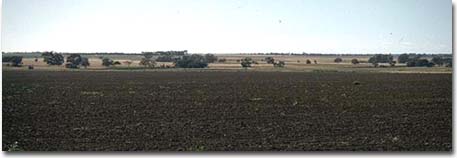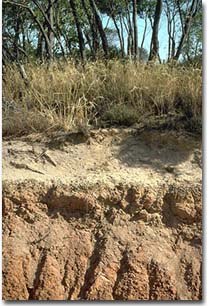Undulating Low Hills
Description of the Mapping Unit
Landform and Distribution
This unit consists of a number of pronounced NNW/SSE trending ridges with relief varying between 30-80 m. The larger ridges consist of a number of components e.g. broad crests, flat ledges, long slopes. The slopes can vary greatly but are usually in the range of 1-6%. The major ridges mapped are referred to here as the Diapur (known locally as 'Lawloit Range'), Netherby, Propodollah and Little Desert Ridges.
The parent material of these ridges is sandstone (Parilla Sand). Since their formation different parts of the ridges have also been covered by variable deposits of aeolian sand and calcareous clay. A laterite (ironstone accumulation) layer occurs on parts of the larger ridges, indicating that alternating wet-humid and dry climatic periods existed during soil formation.
 Propodollah Ridge |
Adjacent Mapping Units:
This mapping unit is found adjacent to the Gently Undulating Plains unit (lower in the landscape) and Gently Undulating Sand Plains and Rises. In the south and west of the study area, Grey Clay Plains also adjoins this unit - occurring lower in the landscape.
Native Vegetation
Mallee eucalypts, including Broombush (Melaleuca uncinata), on deeper sandy areas. Yellow Gum (E. leucoxylon) can occur on areas without deeper sands.
Soil Types
Three general soil types are found in this land system; Grey Sodosols (deep sandy surfaces); Grey and Yellow Sodosols (sandy surfaces) and Brown Sodosols (sandy loam-clay loam surfaces). Soil pit Site LS4, Site LS5 and Site LS6 form a cross section across part of the Diapur Ridge and give an indication of the variable nature of soil formation on these ridges. The soil on Site LS4 has developed on the sandstone parent material and has in more recent times been covered with siliceous sands. It has not received any windblown carbonate material and is acidic throughout. It also has a weakly developed ironstone layer. It can be described as a deep sandy Grey Sodosol. Site LS5 occurs on a minor ledge and has a soil that is classified as a Brown Sodosol (Great Soil Group is solonetz). It has received deposits of windblown calcareous clay and has a deep subsoil horizon which is strongly alkaline and contains a zone of soft carbonate accumulation. On a midslope of the ridge a Grey Sodosol has developed. It too has received carbonate accessions and shows a well developed profile, with an acid sandy surface horizon overlying bleached sand with variable amounts of ironstone accumulation. The top of the subsoil has characteristic columnar structure with a hard bleached capping (Great Soil Group is solodized solonetz). The subsoil becomes more alkaline with increasing depth.
Other soils noted on the Diapur Ridge are Ferric Brown Sodosols which generally have a slightly acid sandy loam surface soil; a conspicuously bleached light sandy loam A2 horizon (with depth varying from 10-30 cm) which includes more than 20% of ironstone gravel and a slightly acid light medium clay subsoil with no carbonate. These soils are most likely to occur on the Diapur and Little Desert Ridges. Grey Vertosols also occur on the Diapur Ridge and some of these areas have been mapped as part of the Grey Clay Plains unit.
 | Soils sampled on the Netherby Ridge are generally mottled Grey Sodosols with sand to sandy loam surface horizons which are moderately to strongly alkaline. Bleached A2 horizons (of generally 20-40 cm depth) exist with a patchy distribution and overlie a sandy medium clay subsoil which is moderately to very strongly alkaline and strongly sodic. Carbonate accumulations also occur. Soils on the Propodollah Ridge are generally mottled Yellow and Grey Sodosols with slightly acid loamy sand surface soil on top of a bleached sandy A2 horizon. The subsoil is usually a strongly alkaline mottled medium clay. The top of the subsoil may or may not have developed a coarse domed columnar structure. The relevant Great Soil Group is solodic or solodized solonetz and these two soils may be intermixed. A Ferric (i.e. ironstone accumulation) horizon may also be present. Areas of deeper surface sands occur in patches. |
The Undulating Low Hills unit is susceptible to wind, sheet, rill and gully erosion due to a combination of factors such as degree of slope, slope length and soil type. The sandy surface horizons are prone to wind erosion, and once removed expose sodic and strongly dispersive subsoils to water erosion.
Soil Characteristics and Management Options


